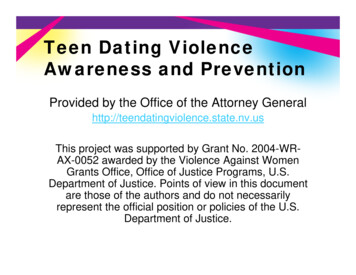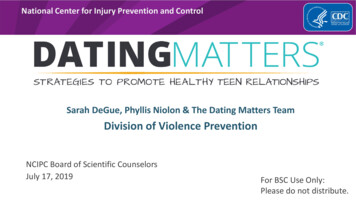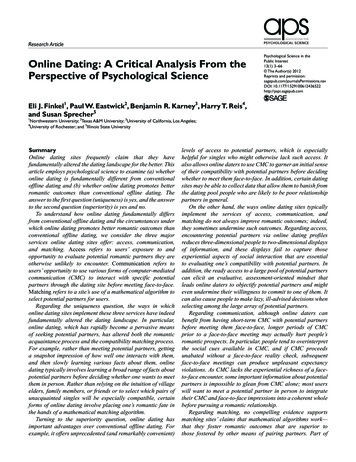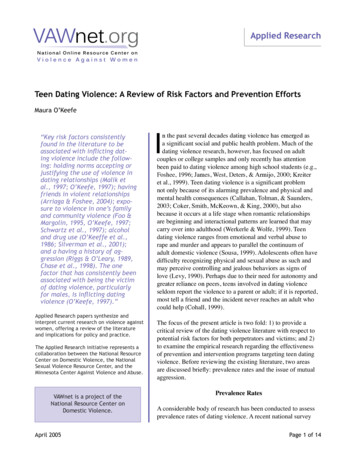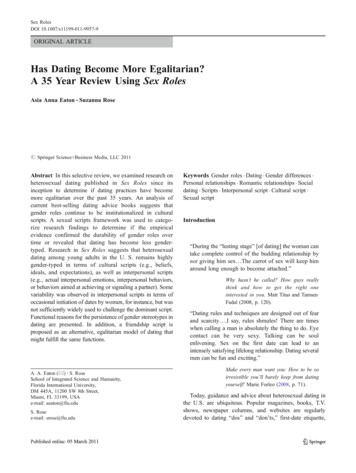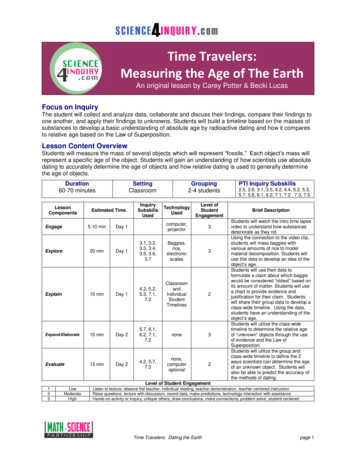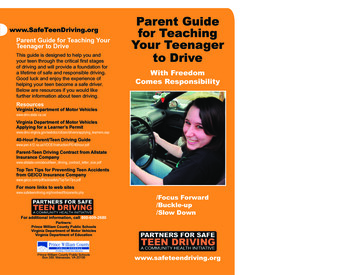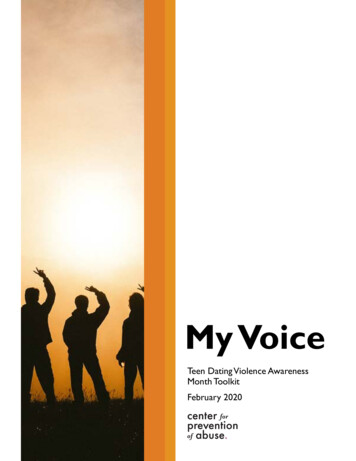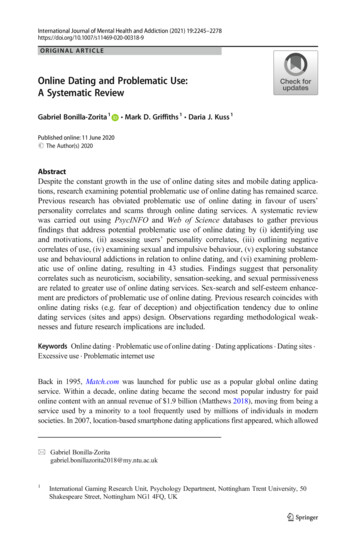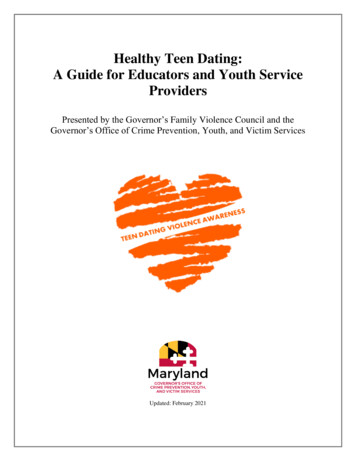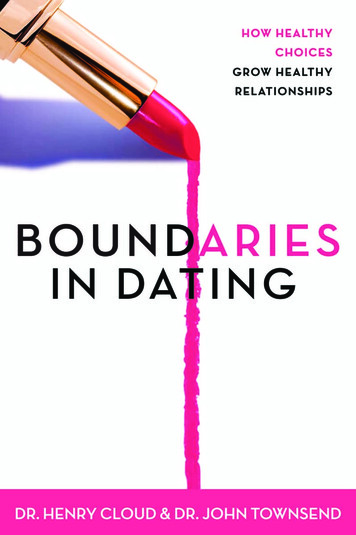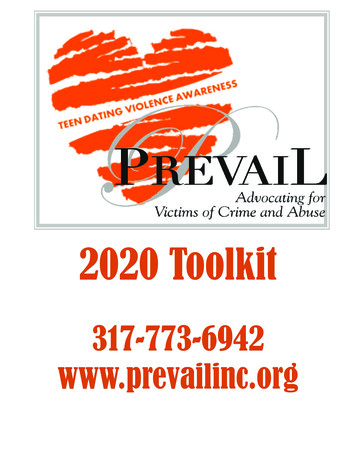
Transcription
2020 Toolkit317773--6942317--773www.prevailinc.org
January 2020Dear Community Partner,We are pleased to present to you Prevail’s 2020 Teen Dating Violence Prevention Month(TDVPM) Toolkit. Inside you will find information about resources, discussion starters,activities, and handouts about teen dating violence. Our hope is that you look through thistoolkit and consider what you can do to bring awareness to this very important issue.One in every three teens will have experienced some form of abuse in a dating relationshipbefore they reach adulthood. At Prevail, adolescent services are our fastest growing population.With this understanding, our hope is to unite our community in creating spaces for teens torecognize and develop healthy relationships with themselves and those around them. Our teensare surrounded with many conflicting messages about relationships from friends, family,movies and television shows, and social media. As adults, you have the unique opportunity toguide and educate young people so they can experience a future free of violence.We encourage you to “Go Orange” with us by wearing an orange article of clothing onFebruary 14th and post a picture online using the hashtag #GoOrangePrevail.Teen dating violence occurs every day in our community, so it is important for each of us tocome together and bring about change. While intervention is important, there is a need to raiseawareness and work to prevent teen dating violence from occurring in the first place. Includedin this toolkit are activity suggestions ranging from five minute conversations to full lessonplans, so there are many options to fit the time you have available. Please consider what partyou can play in creating a culture that does not permit, allow, or tolerate violence.Thank you for your support and active involvement with the teens in our community. We reallycannot bring about change without you! If you would like more information about Prevail’sTDVPM Toolkit or teen dating violence, contact Youth Advocacy Supervisor Kelly Ferriell atkferriell@prevailinc.org or Primary Prevention Specialist Kelly Growden atkgrowden@prevailinc.org. Both are available via phone by calling our office at 317-773-6942.
AT A GLANCE– INTRODUCTIONAdvocating for Victims of Crime & AbuseFor more information about Prevail visit:www.prevailinc.org2020 Teen Dating Violence ToolkitDates: The entire month of FebruaryReview the handouts and activity list and decidewhat you want to do to bring awareness aboutdating violence and healthy relationships.Call Prevail (317-773-6942) to schedule a HealthyRelationships presentation or schedule a tour of thePrevail Staff will “Go Orange” on FebruaryPrevail office.14, 2020. Join us by wearing your orangegear! Post a picture using the hash tag#GoOrangePrevail.Teen Dating Violence Quick Facts* The Centers for Disease Control, who haveclassified Teen Dating Violence as a publichealth issue, estimates that over 1.5 millionteens experience abuse by a dating partnerin a single year. One in ten high school students haspurposely been hit, slapped, or physicallyhurt by a dating partner. Violent behavior typically begins between theages of twelve and eighteen. Only a third of surveyed teens report tellinganyone about the abuse they have experienced or currently are enduring.Toolkit FormatWithin this toolkit, you will find a facts and statisticssheet, reproducible handouts, activities for differentsizes of groups, discussion/conversation starters, atips for teachers sheet, two example lesson plans,and local and national resources. We encourageyou to utilize any or all pieces of this toolkit and toadd your own ideas and suggestions throughout themonth.QUICK PLANNING TIPSUse #GoOrangePrevail when posting to socialmediaFollow us on Facebook (Prevail, Inc), Twitter(prevail inc) and Instagram (Prevail.inc) to see andshare our daily posts.* Statistics provided by Love is Respect and canbe found at loveisrespect.org
Supporting Victimsof Crime & AbuseMy partner doesn’t punch me.So, I wouldn’t call it ‘abuse’ butsomething is very wrong.Abuse, domestic violence and sexualassaut are scary words. It may be difficultto believe that it could be happening toyou. Even if you just have the feeling thatsomething is wrong in your relationship,we can help. You can find your voice.I wish I could help my friend,but I don’t know how.Encourage your friend to reach out tous at Prevail. Their safety is the mostimportant thing to consider.Your support makes what we do possible.Here’s what you can do to helpPrevail help others. S hare Prevail information with others. I nvite us to speak with your organization. S ponsor and/or attend a Prevail event. M ake a donation. H ost a supply drive. Volunteer. S ign up for our enewsletter online. F ollow us on social media and share.Si estás en crisis llama a la linea(317) 776-3472 para hablar con unaconsejera quien te puede ayudar.Se proveerá de traductores para laspersonas que no hablan inglés.All services are freeand confidential.1100 S. 9th Street, Suite 100Noblesville, IN 46060Office: 317-773-694224-Hour Crisis Line: 317-776-3472Fax: rg/Prevailinc@Prevail Inc24-Hour Crisis Line:317-776-3472
I care about you and Iwill support you, if youwant. I know it is scarybut you can do this.Anyone who has experiencedabusive situations can receive helpfrom Prevail’s advocates.Just as every person, situation andstory is unique, there is no onepath that fits everyone. An advocatelistens, shines a light on multipleoptions and gives encouragement.Also, Prevail’s services are freeand confidential.YOUR SAFETY PLANGetting out of a bad situationcan be tricky. We can talk to youabout ways that you might besafer in your situation, includingexploring a Protective Order(Restraining Order). Remember,we are always available to talk withyou on the 24-hour crisis line.YOUR ADVOCATEYou can meet one-on-one witha Prevail advocate. An advocateis your supporter. They helpempower you in your situation.When you decide on your nextsteps, you will not be alone.YOUR FAMILYWhen trauma happens, it canhappen to the whole family.Advocates work with children whohave witnessed or experiencedtrauma. Prevail also offers supportfor non-offending parents/guardians whose children haveexperienced trauma.YOUR NEW STARTWhen you make a new start,some real-life challengesmay seem impossible. Weprovide assistance to findhousing, employment, food,transportation, budget planningand more.YOUR COURT SUPPORTPrevail works hand-in-handwith the Hamilton CountyProsecutor’s Office and othercourt entities to help younavigate through the legalaspects of your situation.YOUR GROUPIt’s true – there is strength innumbers. Each week, Prevailoffers many support groups toconnect people together thathave gone through similarexperiences.YOUR STORYWe visit schools, givepresentations, train teachers andmore. One day, you may want toshare your story as a way to helpeducate others.
Activities/Discussion Starters Review the Dating Abuse Statistics handout (included in this toolkit). How do you think these facts relate to yourschool, team, workplace, faith community, or family? Learn about the Relationship Spectrum (handout included in this toolkit). Consider where your current relationshipswould fall on the spectrum. Take the Healthy Relationship Quiz (included in this toolkit) to see if your current relationship is safe. Discuss thescores with friends or adults you trust. Take the Am I A Good Partner Quiz (included in this toolkit) and discuss the results with friends or adults you trust. Draw a picture of your relationship boundaries. What behaviors do you feel safe, maybe safe, and unsafe with? How doyou want others to treat your body, your emotions, your words, your thoughts, your personal space, your sexualneeds, your spiritual beliefs, your money, and your time? There is an example drawing included in this toolkit. Watch an episode of a television show. Discuss where the characters’ relationships would fall on the RelationshipSpectrum. Some examples to consider are Empire (Cookie/Luscious), Gilmore Girls (Rory/Dean, Luke/Lorelai),Riverdale (Archie/Betty), Scandal (Olivia/Fitz), Pretty Little Liars (Aria/Ezra), Gossip Girl (Blair/Chuck), or Orange isthe New Black (Piper/Alex). Print off the lyrics of popular songs. Read the actual words. What is being communicated about other people in thesong? Is the message one about safe and healthy relationships or do the verses refer to people in disrespectful ways?Use the Sound Relationships sheet (included in this toolkit) to guide your conversation. Songs including “Love the WayYou Lie” by Eminem, “Issues” by Julia Michaels, “Grave Yard” by Halsey, “Perfect” by Ed Sheeran, and “Stay WithMe” by Sam Smith are some options. Feel free to find your own.
Activities/Discussion Starters Continued Talk about conflict resolution. In what ways is this important? Why do we try to hide from or avoid conflict? How canwe see conflict as an important part of the communication process with others? How to you respond to (or avoid)conflict? Does this help you get your needs met or do you put the needs of others before what you need? Identify resources you could use or refer a teen to if you have concern about their relationship. Write these downsomewhere easily accessible, just in case. You can refer to the resources page included in this toolkit. Create a “Love is ” wall. Use the included speech bubbles and create a dynamic display of what you and others thinkis an important part of a healthy relationship. Leave this up to allow reflection and discussion. Create your own “Relationship Bill of Rights”. Consider what you want and need from a dating partner and what thingsyou will not accept or tolerate. Everyone has the right to be safe. Use the included My Declaration of Rights page tostart your thinking. Watch the “Consent is a Yes” on YouTube. Discuss what consent really means. Practice having conversations givingand requesting consent. Consider how many times each day you give consent (sharing your food, giving someone aride to school, hanging out). Remember that “No” is a complete sentence. Create a poster, public service announcement, social media post, or other awareness project shedding light on TeenDating Violence and/or healthy relationships. Use the included scenario flashcards to decide if each situation is healthy or unhealthy. Talk about your answers andhow you came to your decisions. An answer key and discussion points are also included in this toolkit.Prevail, Inc.(317) 773-6942 www.prevailinc.orgth1100 S. 9 Street, Suite 100 Noblesville, Indiana 46060
Dating Abuse StatisticsDating abuse is a big problem, affecting youth in every community across the nation. Learn the facts below.Too Common Nearly 1.5 million high school students nationwide experience physical abuse from a dating partner in a single year.1 One in three girls in the US is a victim of physical, emotional or verbal abuse from a dating partner, a figure that farexceeds rates of other types of youth violence. 2 One in ten high school students has been purposefully hit, slapped or physically hurt by a boyfriend or girlfriend.3Why Focus on Young People? Girls and young women between the ages of 16 and 24 experience the highest rate of intimate partner violence,almost triple the national average. 4 Among female victims of intimate partner violence, 94% of those age 16-19 and 70% of those age 20-24 werevictimized by a current or former boyfriend or girlfriend. 5 Violent behavior often begins between the ages of 12 and 18. 6 The severity of intimate partner violence is often greater in cases where the pattern of abuse was establishedin adolescence.7Don’t Forget About College Students Nearly half (43%) of dating college women report experiencing violent and abusive dating behaviors.8 College students are not equipped to deal with dating abuse – 57% say it is difficult to identify and 58% say theydon’t know how to help someone who’s experiencing it.9 One in three (36%) dating college students has given a dating partner their computer, email or social networkpasswords and these students are more likely to experience digital dating abuse.10 One in six (16%) college women has been sexually abused in a dating relationship.11Long-lasting Effects Violent relationships in adolescence can have serious ramifications by putting the victims at higher risk for substanceabuse, eating disorders, risky sexual behavior and further domestic violence.12 Being physically or sexually abused makes teen girls six times more likely to become pregnant and twice as likelyto get a STD.13 Half of youth who have been victims of both dating violence and rape attempt suicide, compared to 12.5% ofnon-abused girls and 5.4% of non-abused boys.14 Lack of Awareness Only 33% of teens who were in an abusive relationship ever told anyone about the abuse.15 Eighty-one (81) percent of parents believe teen dating violence is not an issue or admit they don’tknow if it’s an issue.16 Though 82% of parents feel confident that they could recognize the signs if theirchild was experiencing dating abuse, a majority of parents (58%) could notcorrectly identify all the warning signs of abuse.17For more information, visit www.loveisrespect.orgRepurposing is allowed and encouraged.Please contact loveisrespect for more information.
Centers for Disease Control and Prevention, “Physical Dating Violence Among High School Students—United States,2003,” Morbidity and Mortality Weekly Report, May 19, 2006, Vol. 55, No. 19.2Davis, Antoinette, MPH. 2008. Interpersonal and Physical Dating Violence among Teens. The National Council on Crimeand Delinquency Focus. Available at http://www.nccd-crc.org/nccd/pubs/2008 focus teen dating violence.pdf.3Grunbaum JA, Kann L, Kinchen S, et al. 2004. Youth Risk Behavior Surveillance—United States, 2003. Morbidity andMortality Weekly Report. 53(SS02); 1-96. Available at htm.4Department of Justice, Bureau of Justice and Statistics, Intimate Partner Violence in the United States, 1993-2004.Dec. 2006.5Callie Marie Rennison, Ph.D., Department of Justice, Bureau of Justice Statistics, “Intimate Partner Violence and Age ofVictim, 1993-99” (2001). Available at: f6Rosado, Lourdes, The Pathways to Youth Violence; How Child Maltreatment and Other Risk Factors Lead Children toChronically Aggressive Behavior. 2000. American Bar Association Juvenile Justice Center.7S.L. Feld & M.A. Strauss, Criminology, 27, 141-161, (1989).8Fifth & Pacific Companies, Inc. (Formerly: Liz Claiborne, Inc.), Conducted by Knowledge Networks, (December 2010).“College Dating Violence and Abuse Poll,” Available at: https://www.breakthecycle.org/surveys.9Fifth & Pacific Companies, Inc. (Formerly: Liz Claiborne, Inc.), Conducted by Knowledge Networks, (December 2010).“College Dating Violence and Abuse Poll,” Available at: https://www.breakthecycle.org/surveys.10Fifth & Pacific Companies, Inc. (Formerly: Liz Claiborne, Inc.), Conducted by Knowledge Networks, (December 2010).“College Dating Violence and Abuse Poll,” Available at: https://www.breakthecycle.org/surveys.11Fifth & Pacific Companies, Inc. (Formerly: Liz Claiborne, Inc.), Conducted by Knowledge Networks, (December 2010).“College Dating Violence and Abuse Poll,” Available at: https://www.breakthecycle.org/surveys.12Jay G. Silverman, PhD; Anita Raj, PhD; Lorelei A. Mucci, MPH; Jeanne E. Hathaway, MD, MPH, “Dating ViolenceAgainst Adolescent Girls and Associated Substance Use, Unhealthy Weight Control, Sexual Risk Behavior, Pregnancy,and Suicidality” JAMA. 2001;286(5):572-579. doi:10.1001/jama.286.5.57213Decker M, Silverman J, Raj A. 2005. Dating Violence and Sexually Transmitted Disease/HIV Testing and DiagnosisAmong Adolescent Females. Pediatrics. 116: 272-276.14D. M. Ackard, Minneapolis, MN, and D. Neumark-Sztainer, Division of Epidemiology, School of Public Health, Universityof Minnesota, Minneapolis, MN, Date Violence and Date Rape Among Adolescents: Associations with Disordered EatingBehaviors and Psychological Health, Child Abuse & Neglect, 26 455-473, (2002).15Liz Claiborne Inc., conducted by Teenage Research Unlimited, (February 2005).16“Women’s Health,” June/July 2004, Family Violence Prevention Fund and Advocates for mer04/p03-dating.html.17Fifth & Pacific Companies, Inc. (Liz Claiborne, Inc.), Conducted by Teen Research Unlimited, (May 2009). “TroubledEconomy Linked to High Levels of Teen Dating Violence & Abuse Survey 2009,”Available at: https://www.breakthecycle.org/surveys.1For more information, visit www.loveisrespect.orgRepurposing is allowed and encouraged. Please contact loveisrespect for more information.
THE RELATIONSHIP SPECTRUMAll relationships exist on a spectrum from healthy to abusive with unhealthy somewhere in the middleHealthy relationships are based on equality and respect.RESPECTGOOD COMMUNICATIONTRUSTHONESTYEQUALITYYou make decisions together and can openlydiscuss whatever you’re dealing with, like relationship problems and sexual choices. You enjoyspending time together but can be happy apart.Unhealthy relationships are based onattempts to control the other person.BREAKS IN COMMUNICATIONPRESSUREDISHONESTYSTRUGGLES FOR CONTROLINCONSIDERATE BEHAVIOROne person tries to makemost of the decisions. Heor she may pressure theirpartner about sex or refuseto see how their actions canhurt. In an unhealthy relationship, you feel like you shouldonly spend time with yourpartner.Abusive relationships are based onan imbalance of power and control.ACCUSATIONSBLAME SHIFTINGISOLATION PRESSUREMANIPULATIONOne person is making all of the decisions — about sexualchoices, friend groups, boundaries, even what’s trueand what’s not. You spend all of your time together andfeel like you can’t talk to other people, especially aboutwhat’s really happening in your relationship.This project described was supported by Grant Number 90EV0426 from the Administration on Children, Youth and Families, Family and Youth Services Bureau, U.S. Department of Health and Human Services.The opinions, findings, conclusions and recommendations expressed in this publication are those of the author(s) and do not necessarily reflect the views of the Administration on Children, Youth and Families,Family and Youth Services Bureau, U.S. Department of Health and Human Services.
Healthy Relationship QuizEVERYONE DESERVES TO BE IN A SAFE AND HEALTHY RELATIONSHIP. DO YOU KNOW IF YOUR RELATIONSHIPIS HEALTHY? ANSWER YES OR NO TO THE FOLLOWING QUESTIONS TO FIND OUT. MAKE SURE TO CHECKTHE BOXES TO RECORD YOUR RESPONSES. AT THE END, YOU’LL FIND OUT HOW TO SCORE YOUR ANSWERS.THE PERSON I’M WITH1.YESIs very supportive of things that I do.2. Encourages me to try new things.3. Likes to listen when I have something on my mind.4. Understands that I have my own life too.5. Is not liked very well by my friends.6. Says I’m too involved in different activities.7. Texts me or calls me all the time.8. Thinks I spend too much time trying to look nice.9. Gets extremely jealous or possessive.10. Accuses me of flirting or cheating.11. Constantly checks up on me or makes me check in.12. Controls what I wear or how I look.13. Tries to control what I do and who I see.14. Tries to keep me from seeing or talking to my family and friends.15. Has big mood swings, getting angry and yelling at me one minute but being sweet and apologetic the next.16. Makes me feel nervous or like I’m “walking on eggshells.”17. Puts me down, calls me names or criticizes me.18. Makes me feel like I can’t do anything right or blames me for problems.19. Makes me feel like no one else would want me.20. Threatens to hurt me, my friends or family.21. Threatens to hurt themselves because of me.22. Threatens to destroy my things (Phone, clothes, laptop, car, etc.).23. Grabs, pushes, shoves, chokes, punches, slaps, holds me down, throws things or hurts me in some way.24. Breaks or throws things to intimidate me.25. Yells, screams or humiliates me in front of other people.26. Pressures or forces me into having sex or going farther than I want to.FOR MORE INFORMATION, VISIT WWW.LOVEISRESPECT.ORGNO
Healthy RelationshipSCORINGGIVE YOURSELF ONE POINT FOR EVERY NO YOU ANSWERED TO NUMBERS 1-4, ONE POINT FOR EVERYYES RESPONSE TO NUMBERS 5-8 AND FIVE POINTS FOR EVERY YES TO NUMBERS 9 AND ABOVE.NOW THAT YOU’RE FINISHED AND HAVE YOUR SCORE, THE NEXT STEP IS TO FIND OUT WHAT IT MEANS.SIMPLY TAKE YOUR TOTAL SCORE AND SEE WHICH OF THE CATEGORIES BELOW APPLY TO YOU.You got a score of zero? Don’t worry -- it’s a good thing! It sounds like your relationship is on a prettyhealthy track. Maintaining healthy relationships takes some work -- keep it up! Remember that while youmay have a healthy relationship, it’s possible that a friend of yours does not. If you know someone who is inan abusive relationship, find out how you can help them by visiting loveisrespect.org.0pts1-2pts3-4pts5ptsIf you scored one or two points, you might be noticing a couple of things in your relationship that areunhealthy, but it doesn’t necessarily mean they are warning signs. It’s still a good idea to keep an eye outand make sure there isn’t an unhealthy pattern developing.The best thing to do is to talk to your partner and let them know what you like and don’t like. Encouragethem to do the same. Remember, communication is always important when building a healthy relationship.It’s also good to be informed so you can recognize the different types of abuse.If you scored three or four points, it sounds like you may be seeing some warning signs of an abusiverelationship. Don’tignore these red flags. Something that starts small can grow much worse over time.No relationship is perfect -- it takes work! But in a healthy relationship you won’t find abusive behaviors.If you scored five or more points, you are definitely seeing warning signs and may be in an abusive relationship.Remember the most important thing is your safety -- consider making a safety plan.You don’t have to deal with this alone. We can help. Chat with a trained peer advocate to learn about yourdifferent options at loveisrespect.org.This project described was supported by Grant Number 90EV0426 from the Administration on Children, Youth and Families, Family and Youth Services Bureau, U.S. Department of Health andHuman Services. The opinions, findings, conclusions and recommendations expressed in this publication are those of the author(s) and do not necessarily reflect the views of the Administrationon Children, Youth and Families, Family and Youth Services Bureau, U.S. Department of Health and Human Services.
Am I a Good Partner? QuizARE YOU A GOOD PARTNER? ANSWER YES OR NO TO THE FOLLOWING QUESTIONS TO FIND OUT. MAKE SURE TOCHECK THE BOXES TO RECORD YOUR RESPONSES. AT THE END, YOU’LL FIND OUT HOW TO SCORE YOUR ANSWERS.DO IYESNO1. Forget to thank my partner when they do something nice for me?2. Ignore my partner’s calls if I don’t feel like talking?3. Get jealous when my partner makes a new friend?4. Have trouble making time to listen to my partner when something is bothering them?5. Discourage my partner from trying something new like joining a club?6. Call, text or drive by my partner’s house a lot?7. Get upset when my partner wants to hang out with their friends or family?8. Make fun of my partner or call them names?9. Criticize my partner for their taste in music or clothing?10. Make fun of my partner’s appearance?11. Accuse my partner of flirting or cheating even if I’m not sure that’s what happened?12. Take out my frustrations on my partner, like snapping at them or giving them attitude?13. Throw things if I’m mad at my partner or do things like hit walls or drive dangerously?14. Read my partner’s texts or go through their personal things, like their wallet or purse?15. Tell my partner they are the reason for my bad mood even if they aren’t?16. Try to make my partner feel guilty about things they have no control over?17. Sometimes say things to my partner knowing that they are hurtful?18. Talk down to or embarrass my partner in front of others?19. Make/encourage my partner to do things sexually that I know they don’t want to do?WE ARE HERE TO HELPCHAT: 24/7/365 CALL: 1.866.331.9474 TEXT: LOVEIS TO 22522FOR MORE INFORMATION, VISIT WWW.LOVEISRESPECT.ORG
So Are You A Good Partner?SCORINGGIVE YOURSELF ONE POINT FOR EVERY “YES” YOU ANSWERED TO QUESTIONS ONE THROUGH FOUR AND FIVEPOINTS FOR ALL “YES” ANSWERS TO NUMBERS 5-20. DON’T GIVE YOURSELF ANY POINTS FOR ANY “NO” ANSWERS.NOW THAT YOU’RE FINISHED AND HAVE YOUR SCORE, THE NEXT STEP IS TO FIND OUT WHAT IT MEANS.SIMPLY TAKE YOUR TOTAL SCORE AND SEE WHICH OF THE CATEGORIES BELOW APPLY TO YOU.0ptsIf you got zero points, congratulations! You make a good Partner! It sounds like you’re very mindful of youractions and respectful of your partner’s feelings -- these are the building blocks of a healthy relationship.Keeping things on a good track takes work, so stay with it! As long as you and your partner continue likethis, your relationship should grow in a healthy direction.1-2ptsIf you scored one or two points, there may be a couple of things in your relationship that could use a littleattention. Nobody is perfect, but it is important to be mindful of your actions and try to avoid hurting yourpartner. Remember, communication is key to building a healthy relationship!3-4ptsIf you scored three or four points, it’s possible that some of your actions may hurt your partner andrelationship. While the behaviours may not be abusive, they can worsen over time if you don’t change.5ptsIf you scored five or more points, some of your actions may be abusive. You may not realize it, but thesebehaviours are damaging. The first step to improving your relationship is becoming aware of yourunhealthy actions and admitting they are wrong. It’s important to take responsibility for the problem andget help to end it. An unhealthy pattern is hard to change, so chat with a peer advocate at loveisrespect.orgfor more information on how to get help.This project described was supported by Grant Number 90EV0426 from the Administration on Children, Youth and Families, Family and Youth Services Bureau, U.S. Department of Health andHuman Services. The opinions, findings, conclusions and recommendations expressed in this publication are those of the author(s) and do not necessarily reflect the views of the Administration onChildren, Youth and Families, Family and Youth Services Bureau, U.S. Department of Health and Human Services.
Nutritional ImpactArtist:Song title:Serving Size: Min:Amount per serving:Sec:Present(X)Intensity level(1-10)Unhealthy Relationship tionship sexManipulationTotal UnhealthyHealthy Relationship tTotal HealthyThe song may portray: Drama: a belief that making up/breaking up, yelling, bitter arguing,destroying property or a general sense that unhealthy conflict in the relationship is part of anormal relationship. Possession/Obsession: a belief that another person is an object to usefor one’s personal benefit. This could also include stalking, objectification, and controllingbehavior. Disrespect: a belief that it is acceptable to disregard another person’s feelings,ideas, opinions and wishes. This could include name calling, put downs, minimizing language, and cheating. Relationship sex a belief that the main component or focus of therelationship is sex. Manipulation: a belief that it is acceptable to lie or use another person’semotions or vulnerabilities to get what is desired. This could include guilt trips, lying, andusing alcohol to get sex. Fun/Enjoyable: a belief that relationships are enjoyable and fun.Support: a belief that a relationship includes building up the other person’s confidence andstrengths. This could include encouraging another person to make healthy decisions tobetter themselves, even when the other person may not totally agree. Respect: a beliefthat another person has value and is appreciated and recognized for their ideas, thoughts,and decisions. This could include the use of positive or supportive words to describe theother person. Equality: a belief that both parties share in decision making and are free tochoose what is right for them. One person does not have power over the other either indecision making or sex. Trust: a belief that the other person in the relationship has yourbest interest at heart. This could include being faithful and honest.Prepared by the Boston Public Health Commission, 2009
Love is.A good partner.
A healthyrelationship.I feel valued when.
1.) I have the right to be treated with respect.2.) I have the right to have and express my own feelings3.) I have the right to say “no” and not feel guilty4.) I have the right to change my mind5.) I have the right to say “I don’t know”6.) I have the right to express anger in a healthy way7.) I have the right to be treated as a capable human being8.) I have the right to have my needs be as important as others needs9.) I Have the right to make mistakes10.) I have the right to ask “why?”11.) I have the right to have and express my own opinions12.) I have the right to set limits on relationships13.) I have the right to take time to respond to someone14.) I have the right to take time to think before I communicate15.) I have the right to take time to meet my own needs16.) I have the right to take time to be alone17.) I have the right to change my goals whenever I want18.) I have the right to change a relationship when my feelings change19.) I have the right to be myself without changing to suit others20.) I have the right to start a relation
Teen Dating Violence Quick Facts* The Centers for Disease Control, who have classified Teen Dating Violence as a public health issue, estimates that over 1.5 million teens experience abuse by a dating partner in a single year. One in ten high schoo
